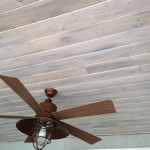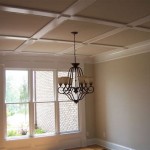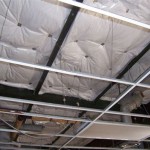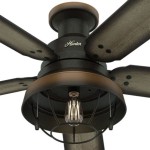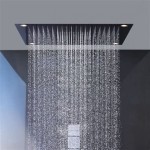False Ceiling Design Photos for Living Room: A Comprehensive Guide
False ceilings, also known as suspended ceilings or dropped ceilings, are secondary ceilings installed below the main structural ceiling. They have become an integral part of modern interior design, particularly in living rooms, serving both aesthetic and functional purposes. The following article provides a detailed exploration of false ceiling designs suitable for living rooms, complemented by an understanding of their advantages, materials, factors influencing design choices, and popular design trends.
The visual impact of a living room is significantly enhanced through the strategic use of false ceilings. They offer a clean, finished look by concealing unsightly elements such as wiring, ductwork, and plumbing pipes. Furthermore, they provide opportunities for integrated lighting solutions, soundproofing, and thermal insulation, contributing to a more comfortable and visually appealing living space. The incorporation of false ceilings allows homeowners to personalize their living rooms, reflecting their style preferences and creating a welcoming environment.
Aesthetic and Functional Advantages of False Ceilings
The adoption of false ceilings in living rooms stems from a combination of aesthetic and functional benefits they provide. These advantages extend beyond mere cosmetic improvements, influencing the overall comfort and efficiency of the living space.
From an aesthetic perspective, false ceilings offer a smooth, uniform surface that hides imperfections in the original ceiling. This creates a more polished and visually appealing environment. The flexibility in design allows for the incorporation of various shapes, patterns, and textures, enabling homeowners to customize the ceiling to match their individual style. The integration of lighting fixtures within the false ceiling is a significant advantage, allowing for ambient, task, and accent lighting to be seamlessly incorporated into the design. This can transform the mood and functionality of the living room.
Functionally, false ceilings contribute to improved thermal insulation, helping to maintain a consistent temperature in the living room. This reduces reliance on heating and cooling systems, leading to energy savings. They also offer soundproofing benefits, minimizing noise transmission from adjacent rooms or external sources, creating a quieter and more relaxing atmosphere. Moreover, false ceilings provide easy access to wiring and ductwork for maintenance and repairs, without disrupting the main ceiling structure.
The impact resistance and durability of false ceiling materials are also noteworthy. Certain materials are more resistant to moisture, fire, and impact than others, allowing for selection based on specific environmental conditions and usage patterns. The ability to integrate fire-rated materials into the false ceiling construction can enhance the safety of the living room in the event of a fire.
Popular Materials for False Ceiling Construction
The choice of material for a false ceiling significantly impacts its appearance, performance, and cost. Several materials are commonly used in residential applications, each with unique properties and characteristics.
Gypsum board is one of the most popular choices for false ceilings due to its versatility, affordability, and ease of installation. It is a lightweight material that can be easily cut and shaped to create various designs. Gypsum boards are also fire-resistant and can be treated to resist moisture, making them suitable for a range of living room environments. They are typically finished with paint or wallpaper to achieve the desired aesthetic look.
Plaster of Paris (POP) is another widely used material for false ceilings. It is a versatile material that can be molded into intricate designs and patterns. POP ceilings offer a smooth, seamless finish and are known for their durability. However, POP requires skilled labor for installation and can be more expensive than gypsum board.
Wooden false ceilings offer a warm, natural aesthetic that can add character to a living room. Wood can be used in various forms, including solid wood planks, wooden panels, and veneered plywood. While wood offers a unique aesthetic appeal, it is important to consider its susceptibility to moisture and fire. Proper treatment and sealing are necessary to ensure the longevity and safety of wooden false ceilings.
PVC (Polyvinyl Chloride) panels are a cost-effective and low-maintenance option for false ceilings. PVC panels are water-resistant, making them suitable for areas with high humidity. They are available in a variety of colors and designs, offering a range of aesthetic options. PVC panels are easy to install and require minimal maintenance.
Metal false ceilings, typically made of aluminum or steel, are often used in commercial and industrial settings, but they can also be incorporated into modern residential designs. Metal ceilings are durable, fire-resistant, and easy to clean. They can be perforated to improve acoustics and are available in a range of finishes.
Factors Influencing False Ceiling Design Choices
Several factors influence the selection of a false ceiling design for a living room. These factors include the size and shape of the room, the architectural style of the house, the budget, and the desired aesthetic effect. A careful consideration of these factors is essential for achieving a harmonious and functional design.
The size and shape of the living room play a crucial role in determining the appropriate false ceiling design. In smaller rooms, simpler designs with minimal drop are often preferred to avoid making the space feel cramped. Larger rooms can accommodate more elaborate designs with multiple levels and intricate detailing. The shape of the room also influences the design; for example, in rooms with irregular shapes, custom designs may be necessary to ensure a cohesive look.
The architectural style of the house should also be considered when selecting a false ceiling design. In traditional homes, designs that complement the existing architectural features are typically preferred. In modern homes, more contemporary and minimalist designs may be more appropriate. The false ceiling should enhance the overall architectural style of the house, creating a unified and harmonious look.
Budget is a significant factor in determining the scope and complexity of the false ceiling design. The cost of materials, labor, and design fees can vary widely depending on the chosen materials, design complexity, and the expertise of the installer. It is important to establish a realistic budget and explore different design options within that budget. Choosing readily available materials and less complex designs can help to reduce costs.
The desired aesthetic effect is a primary consideration in selecting a false ceiling design. The choice of materials, colors, patterns, and lighting fixtures should reflect the homeowner's personal style and preferences. The false ceiling should complement the other design elements in the living room, such as the furniture, flooring, and wall colors. The integration of lighting is particularly important in creating the desired ambiance and mood in the living room.
Popular False Ceiling Design Trends for Living Rooms
False ceiling design trends are constantly evolving, reflecting changes in interior design preferences and technological advancements. Several popular trends are currently shaping false ceiling designs in living rooms.
Minimalist designs are gaining popularity, characterized by clean lines, simple shapes, and neutral colors. These designs focus on functionality and understated elegance, creating a calm and uncluttered living space. Minimalist false ceilings often feature recessed lighting and a smooth, seamless finish, emphasizing simplicity and refinement.
Geometric designs are another popular trend, incorporating bold shapes, patterns, and angles to create a visually striking effect. Geometric false ceilings can add a touch of drama and personality to a living room. These designs often involve the use of multiple levels and contrasting colors to enhance the geometric forms.
Integrated lighting solutions are a key element in modern false ceiling designs. LED strip lighting, recessed spotlights, and pendant lights are commonly used to create ambient, task, and accent lighting. Smart lighting systems allow homeowners to control the lighting remotely, adjusting the brightness and color temperature to suit different moods and activities.
Textured false ceilings are gaining traction, adding depth and visual interest to the living room. Textures can be created using various materials and techniques, such as embossed gypsum boards, textured paints, and decorative panels. Textured false ceilings can add a unique and tactile dimension to the living room design.
Suspended ceilings with open grid designs are becoming increasingly popular, particularly in contemporary homes. These designs create a sense of spaciousness and allow for the integration of natural light. Open grid ceilings can be customized with various infill panels, such as fabric, metal, or wood, allowing for a range of aesthetic options.
Eco-friendly materials are increasingly being used in false ceiling construction, reflecting a growing awareness of environmental sustainability. Recycled gypsum boards, bamboo panels, and other sustainable materials are becoming more readily available, allowing homeowners to create environmentally responsible living spaces.
The integration of ceiling fans into false ceiling designs is also a common practice. False ceilings can be designed to accommodate ceiling fans, providing a seamless and aesthetically pleasing look. The placement and design of the fan should be carefully considered to ensure optimal airflow and functionality.

Modern False Ceiling Designs For Drawing Rooms Elevate Your Space Beautiful Homes

30 Minimalist False Ceiling Designs For Living Room Interior Design

Best False Ceiling Design Ideas For Living Rooms In 2025 Gyproc
.jpg?strip=all)
False Ceiling Designs For Living Room

Stunning Ceiling Design Ideas For Drawing Rooms

50 Budget Friendly False Ceiling Designs For Every Home 2025

Trendy Living Room False Ceiling Designs 2024 Pop Design For Drawing Ceilings I A S

Top 100 Living Room False Ceiling Design Ideas 2024 Pop Designs For

Best False Ceiling Design In Hyderabad At 45 Sq Ft Id 2855722963188

False Ceiling Ideas To Enhance Your Living Room Euphoriainteriors
Related Posts

